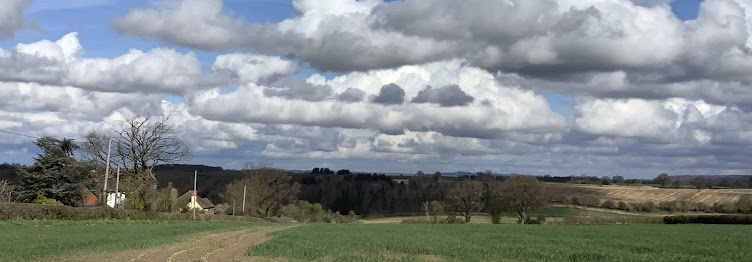As I write, we are coming to the end of what has been a solid week of rain. Thankfully the cottage is on a hill and we have escaped the flooding that has disrupted some parts of Shropshire. So as the garden is looking rather soggy and the summery flowers temporarily defeated, I am glad I took these photos when everything was happier and drier.
A foxglove self seeded
itself in an awkward corner and while my first instinct was to remove
it, I spared it, to see how it would grow. I'm very glad I did, as it
naturally shaped itself around the large lavender bush and has grown to
be roughly six feet tall.
Like the lavender, it is buffeted by westerly winds which push it into a curvaceous line and so they have combined to make a graceful composition that, had I planned it, could not have looked more beautiful.
The front herb patch continues to grow - with very little money, I am slowly filling it out, leaving enough space for everything to spread. Cheap herbs, such as the common and trailing thymes will, over a couple of years, grow rather too well. I hard prune the common
thyme back twice a year, when the bee friendly flowers are finished, but
this year I am going to be more ruthless or it will take over.
At the front of the patch where the shallow growing plants are, there are three types of oregano, four thymes, golden marjoram, trailing rosemary, a French tarragon which struggles, and a few other things including a random tub of parsley used as a space filler.
Common violas, which cost one UK pound a pot, seem to go on forever if they are deadheaded and add subtle splashes of colour. At the back of the trough, the hyssop and blackcurrant sage have tripled in size already. There is a large bare patch for more low growing alpines at some point.
Next to the violas grows dwarf comfrey - it was grown from six stubby roots I picked up cheaply on eBay and has flourished rather too well. However, this is fine, as it was planted for the leaves which I'll be harvesting soon, as they provide an intense, nourishing fertiliser when soaked in water. And when it flowers, it is another bee attraction.
To temporarily fill up spare space, I have pots of pretty summer annuals in front of taller herbs. Since this picture was taken, the herbs have shot up and I am slightly regretting putting (what were) three tiny lemon balm plants. Now shot up and spreading, they are providing the thick cover at the back, which is what I had planned, but will need some taming soon.
One of my favourite finds this year has been 'black' petunias - like many annuals, they hate the rain and are looking bedraggled now, but when they are warm and dry, they look like dark velvet.
I have frequently complained - bitterly - about the amount of rubble and stones which have plagued my digging efforts in the vegetable patch. However, I have found a very good use for some of the more natural shapes; large ones can hold back a vigorous plant from over growing a smaller neighbour and when placed next to a dainty alpine, adds a rather Japanese element (I like to think).
Finally, a rather blurry shot of the 'very tall foxglove' at night, from my Instagram feed. Now is coming to the end of it's glory and I will miss it when it is over.














